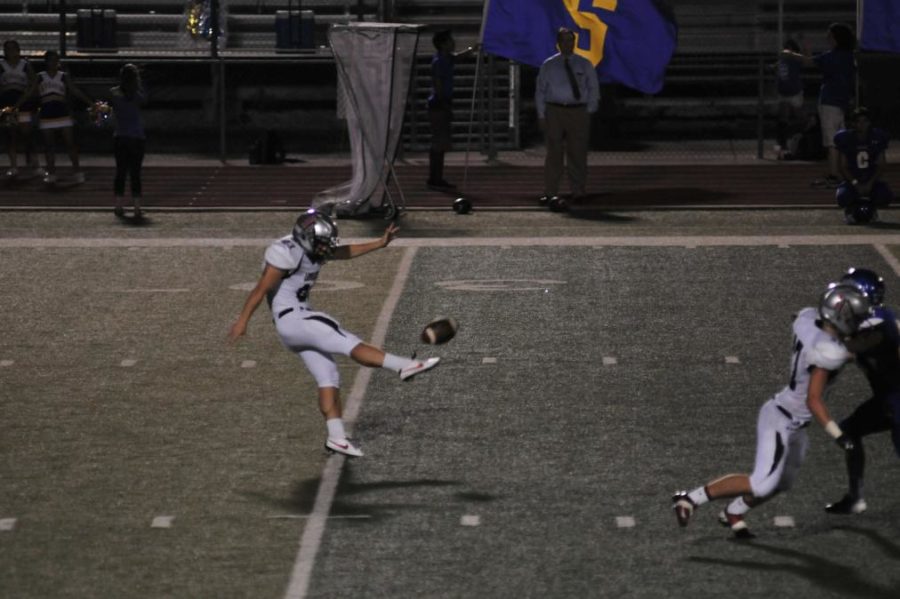Redshirting: an intended advantage
Senior Mick Ellis is one of the many students to take part in the educational trend known as redshirting, in which parents delay school for their kids born close to the cut off date to start school in the hopes that they will have academic or athletic advantages.
April 7, 2014
An educational trend called redshirting is on the rise. It’s when parents delay school for their kids born close to the cut off date to start school, in the hopes that they will have academic or athletic advantages. Some research shows that while older students tend to do better academically and socially, starting school a year later does not always have the benefits parents usually expect.
“The oldest students are approximately twenty percent older than the youngest students at school entry,” a study by professors Elizabeth Dhuey and Kelly Bedard said. “Given the magnitude of the age range on the first day of school, the oldest students are likely to be substantially more mature than the youngest students.”
[sidebar title=”Redshirting statistics” align=”left”]According to one study by Elizabeth Dhuey and Kelly Bedard
-
Older elementary school students score 4 to 12 percent higher on standardized math tests than their younger peers;
-
the oldest middle-school students outperformed younger classmates from 2 to 9 percent
-
older high school students were nearly 12 percent more likely to enroll in a four-year college or university
According to the National Center for Education Statistics
-
When tested on reading skills by age, kindergarten students entering school older than their peers scored significantly higher than their younger peers (2010-2011)
According to the New York Times
-
1 in 11 children did not start kindergarten to be academically redshirted in fall 2011
According to Harvard research (2008)
- Since the late 1960s, the number of 6 year olds in 1st grade has dropped by 9 percent because they are more likely to be enrolled in kindergarten
[/sidebar]
While the original logic behind redshirting came from athletic motives, parents now consider it an option when concerned about academic competition. Many studies conclude that students put in school before they are developmentally ready can be more likely than older students to receive special education, less likely to go to university, and even unlikely to become a CEO.
“Older children within the same grade tend to do better than the youngest, who are less intellectually developed,” Sauder School of Business finance professor Maurice Levi wrote in 2012 referring to his career and age correlation study. “Early success is often rewarded with leadership roles and enriched learning opportunities, leading to future advantages that are magnified throughout life.”
For senior Mick Ellis, the studies in favor of redshirting seem to be accurate. One of the oldest in his class, Ellis will turn 19 in May, 5 days before he graduates.
“I was held back in sixth grade just because I hadn’t hit puberty yet, because I was really young,” Ellis said. “And then freshman year, I started to mature a lot earlier than everybody. I’m not talking like, physically or anything, but on the inside, you know, just mentally. And it helped me with school and a lot stuff like that. It kept me out of drama. It helped me be mature for sure.”
Holding a student back can be beneficial in some cases, but early difficulties in learning often disappear in later grades. The decision to make a student older or younger in their class is often based on determining emotional readiness and the individual situation.
“Older children often have better letter-sound understanding or a larger vocabulary,” educational psychologist and professor Dr. John McNamara said. “And these skills often predict later reading success. However, often younger children who have a good support system have a very strong set of emergent literacy skills. We have to be careful in saying that younger children are always at a disadvantage, because this is simply not the case.”
Being one of the youngest in her class is not necessarily an academic problem for sophomore Katie Albers, born 4 days shy of the cutoff date (September 1) in Texas. At barely 4 years old, Albers’ parents chose to put her in kindergarten because she could already read and write, and was as mature as the rest of her classmates.
“Being young has affected me by not being able to drive until my third day into junior year instead of all my friends being able to drive now,” Albers said. “But being young has only affected me by being able to drive because I feel mature enough to be a sophomore instead of a freshman this year. I’m happy in the grade I’m in now.”
Parents with students who have summer birthdays near the cut off date decide whether to redshirt or not based on an evaluation of social skills, academic readiness, and even the parent’s own experience.
“I knew that you could handle it,” mom Lisa Jackson said to sophomore Rachel Jackson, whose birthday is July 28. “I was younger when I went to high school, so I knew it wasn’t a big deal.”
While either holding a student back or keeping them with their older peers may be more helpful depending on the person and their environment, the rate of redshirting continues to rise even if definite long term effects remain to be seen.
“If holding a child back can give children an advantage, then I think parents are very interested in this,” McNamara said. “Our schools seem to be getting more competitive when it comes to success and this may move parents to finding every competitive edge possible. I don’t think this is necessarily a good thing, but I think it is a common situation none-the-less.”



